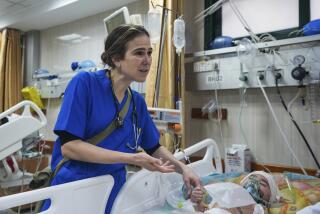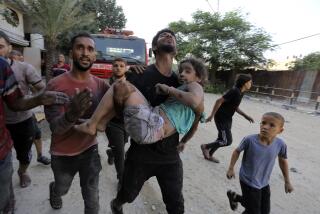Experimenting With Success : Medicine: Cancer research at Children’s Hospital has gained national attention and given hope to families of young patients.
ORANGE — John and Kim Weiner have been spending the holidays at the bedside of their 21-month-old daughter, Samantha, in the intensive care unit for cancer patients at Children’s Hospital of Orange County. There the child is preparing to fight for her life.
Some of Samantha’s bone marrow recently was extracted and frozen in liquid nitrogen. It will be returned to her body to rebuild her strength after she goes through radiation and chemotherapy that are designed to kill the cancer inside her. But the treatment will also severely damage her blood and immune system.
“She will be brought to the edge of death” is how her father describes it.
Twelve years ago, the Weiners, who live in Costa Mesa, would have been forced to send their daughter to another part of the state or country to obtain the same kind of care. But in 1980, Children’s Hospital decided to build a major oncology program, whose work has gained national attention, especially in the development of bone marrow transplantation techniques.
The center did 24 bone marrow transplants in 1992 alone. “We thought in a good year we would be doing 12 to 15,” said Dr. Geni Bennetts, director of the hospital’s division of hematology and oncology.
The progress in fighting childhood cancers has been remarkable. In the past decade, the survival rate for children with cancer nationwide has more than doubled to 60% because of new therapies that have grown out of the research done at Children’s Hospital and other medical centers nationwide.
The most dramatic improvement has been in the treatment of children with lymphoblastic leukemia, the most common form of the cancer that afflicts blood-creating organs, and the type that Samantha has. Bone marrow transplants, combined with more sophisticated chemotherapy, have increased the cure rate for these children from 10% to 70%.
By having bone marrow on hand to help a patient recover, much more aggressive chemotherapy and radiation can be administered in an attempt to annihilate the cancer, explained Dr. Mitchell Cairo, the hospital’s director of cancer research. Cairo said Children’s Hospital has developed a method for using the bone marrow of cancer victims in their treatment when matching bone marrow of healthy siblings or strangers cannot be found.
“We extract their marrow and cleanse it by removing leukemia cells that have become resistant to chemotherapy,” Cairo said. A drug has been found that will bind to a protective protein that develops on the cell and make it permeable to the cancer-fighting chemicals, he said.
In 70% of the cases where the drug has been administered to children, the children have remained cancer free, Cairo said. He added that although he is “excited” by the potential of the new therapy, it will take another couple of years to learn for certain if the cancers are in complete remission.
John Vallely, president of the Pediatric Cancer Research Foundation, which provides most of the $500,000 annual budget for Children’s Hospital’s cancer research, said he wishes the new therapy had been available just 15 months ago, when he lost his 12-year-old daughter Erin to a recurring cancer that would no longer respond to traditional chemotherapy.
When she was appointed, Bennetts’ “mandate was to make it into a formalized program and to participate in national research and clinical trials,” she recalled.
One of her first moves was to recruit Cairo as director of cancer research. He began his work alone in a closet-sized laboratory in the hospital’s basement. Since then, Cairo’s research team has expanded to a dozen members, including immunologists, molecular biologists and other specialists in tissue culture and cell biology.
Vallely said he believes Cairo has “a great calling.” He described Cairo as “basically in war every day and I think he fights for all of them.”
Another director of the Pediatric Cancer Research Foundation, Leonard Buchan, whose 14-year-old son was cured of cancer after three years of intense treatment, said “you never forget about” the trauma of undergoing cancer treatment. “We feel the research helps not only to save kids’ lives but also will make treatment easier on the children if new drugs are found that aren’t as toxic.”
To reduce the sickness that occurs with radiation and chemotherapy, Cairo said, the research program is experimenting with the use of growth factors and interleukins manufactured by biotechnology companies that will spur the child’s marrow to make new blood and rebuild his immune system.
In addition, he said, the research center has developed a chemotherapy program it calls “The Orange Regimen,” after its home county, which is being tried out in 110 medical centers throughout the country to treat pediatric cancer of the lymph glands.
Because childhood cancer is relatively rare, with 10,000 to 15,000 new cases diagnosed nationally each year, Cairo said pediatric cancer centers nationwide have joined together to test the effectiveness of new therapies on significant numbers of patients.
Children’s Hospital also is becoming “a world leader” Cairo said, in the study of using blood cells from umbilical cords in cancer therapy. He said Children’s Hospital researchers have discovered that these cords cut in childbirth contain “stem cells,” which are the generators of new blood, in even richer concentration than these cells are found in bone marrow.
It is Cairo’s hope that by collecting stem cells, a large bank of bone marrow substitutes may be created for cancer treatment. “There is a lot of it and every time a baby is born it could be stored and matched,” he said.
Earlier this month, Children’s Hospital received approval from the National Marrow Donor Program to become one of seven hospitals in California that can transplant bone marrow from unrelated donors. This is very important, Bennetts said, because only 25% to 33% of children who require bone marrow transplants to survive have siblings with a close enough bone marrow match.
For bone marrow to be used without being rejected by the patient’s body, it must match the genetic makeup of the recipient’s marrow very closely--much closer than the type-matching required for a blood transfusion--because it generates a permanent blood supply.
Last month’s opening of a $2-million expansion of Children’s Hospital’s cancer research laboratory drew the attendance of Dr. David Poplak, head of the pharmacology and experimental therapeutics section of the pediatric branch of the National Cancer Institute.
Poplak said he is impressed by how rapidly the Children’s Hospital pediatric cancer research program has advanced to national stature. “Much of the research is state of the art,” he said.
Bennetts praised the work of Cairo, who, she said, “has turned into sort of the shining star here. “It has been wonderful to have his vision.”
Cairo combines an active pediatric practice with basic research, dividing his time between his young patients and the laboratory.
While most oncologists usually choose either research or hands-on medicine, Cairo said he feels he benefits from the interaction of those disciplines. “I like the intellectual challenge of being in the laboratory,” he said. “But at the same time, laboratory results need to be applied, and I think when you have an understanding of the biology of the process, you will have a greater ability to apply it.”
Cairo said he feels personal pain from the death of his patients, which sometimes comes unexpectedly to those who seem on the brink of a cure. That pain, he said, inspires him to work harder.
Late last month, 7-year-old Holly Keuthan, one of Cairo’s patients, died at the same hospital after bone cancer spread through her body. But there are also a growing number of success stories.
“I have many patients who write to keep in touch,” Cairo said. They are in college or have gotten married and some are going to medical school. . . . It feels great. It is the best part of the job. We enjoy taking care of patients and doing basic research, but the biggest joy is to see them get well and live normal lives.”
The Weiner family is one of many hoping their children will benefit from the lengthening track record of the cancer program at Children’s Hospital. “We feel pretty fortunate,” John Weiner said. “They have come a long way over the years. The chemotherapy regimen that Samantha is on isn’t very old. We feel we are in the best hands possible.”






